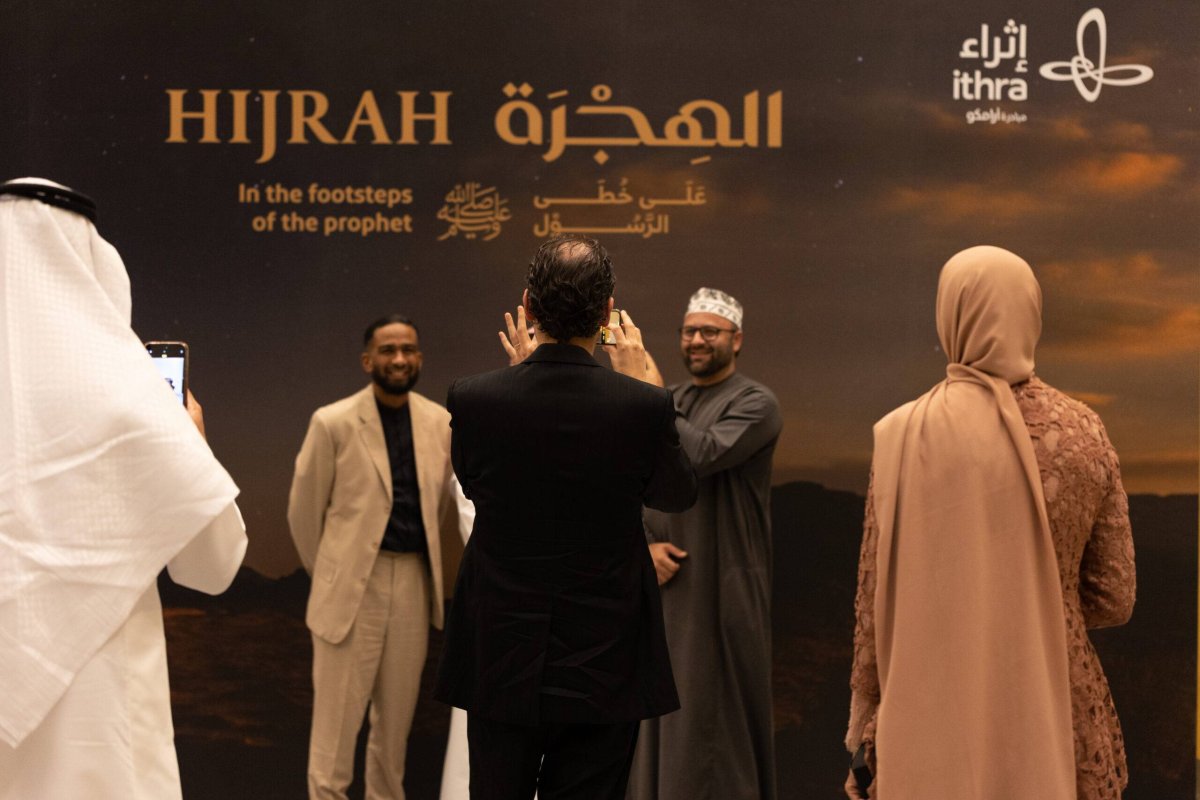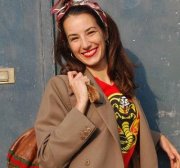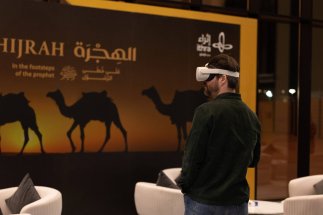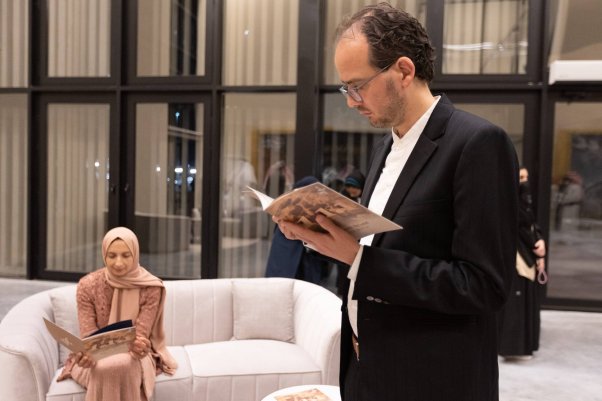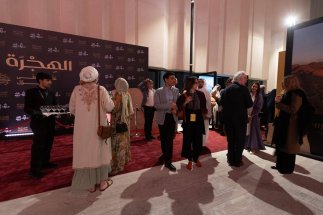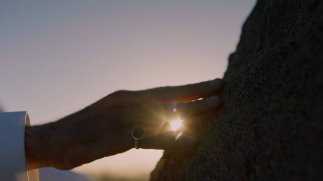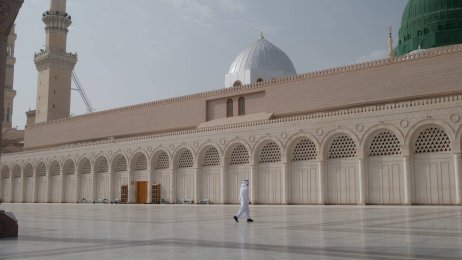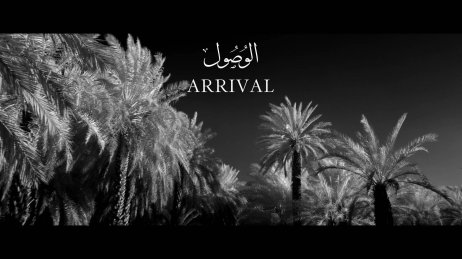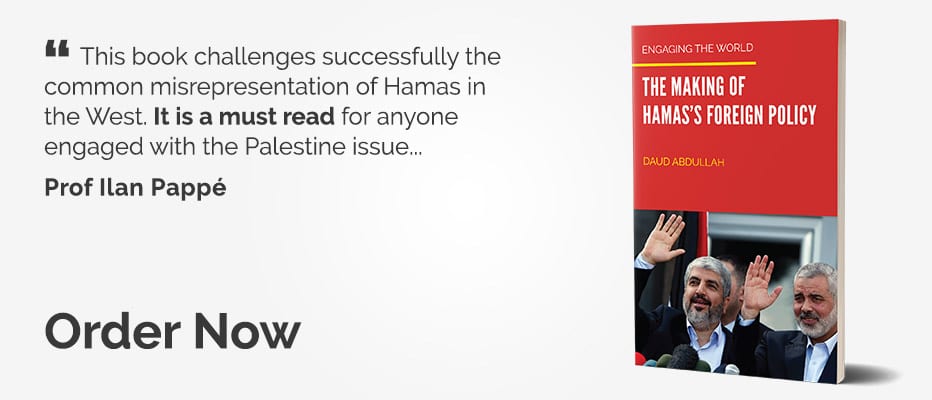The exhibition "Hijrah: In the Footsteps of the Prophet" and the documentary "In the Footsteps of the Beloved" are embracing historical and scientific evidence, signalling a change in Saudi Arabia. There is a long sequence in the movie where a Saudi archaeologist, very thin and emaciated, is walking up a mountain in the desert. A black man is bravely holding an umbrella sheltering him from the sun, and going up the hill with him. It's a long sequence, that seems almost to stress the suffering of the two men.
The archaeologist in the film is actually Dr Abdullah Alkadi, a scholar who — according to a guide at the King Abdulaziz Centre for World Culture (Ithra) — travelled in the footsteps of Prophet Muhammad more than fifty times in order to retrace the Prophet's 8-day journey from Makkah to Madinah in 622, known as the Hijrah.
The surprising part of Alkadi's research is that the archaeologist looked for historical evidence, aided by science and modern technology. His findings sometimes steered away from the official, traditional version. This is something that you don't expect in a country that is still today one of the strictest Islamic theocracies in the world. What I and a bunch of European art people who were flown into the country were wondering in the generously air-conditioned darkness of a cinema in Jeddah was simple: Is this now possible in Saudi Arabia?
READ: US Muslim group slams Israeli assault at Al-Aqsa
"Well, bringing scientific evidence through the medium of art allowed us a bit more freedom of exploration," explained Idries Trevathan, the blue-eyed curator of Ithra, the institution which funded and promoted the movie. Indeed, "In the Footsteps of the Beloved," was described by Ithra as a "poetic documentary."
Always impeccable in his grey suit with a British accent and smile, Trevathan was the friendly face of Ithra, together with the just as distinguished curator of travelling exhibitions, Kumail Almusaly, who conversely had the long Saudi lashes and mellow eyelids, and whose suits were of a warmer tone of grey. They were the perfect pair to translate Islamic ideas and values for a European public.
"Don't expect a classical documentary packed with action," Trevathan warned me just before entering the projection room. "This is more of an art house kind of movie. It's slower. More meditative."
At the beginning of a change
So here I was, in a movie theatre in Saudi Arabia, a country where cinemas were banned for 35 years — except for one IMAX theatre in Al-Khobar — until 2018. This specific cinema in Jeddah was built at the historic Hajj Terminal where the first Islamic Biennale was also taking place, perhaps for the specific purpose of hosting the premiere of "In the Footsteps of the Beloved".
Everything has changed since Saudi Arabia's Crown Prince Mohammed Bin Salman introduced a new social reform plan called Vision 2030, funding an art scene in partnership with the private sector, to create cultural infrastructure, a plan that is bound to extend and expand over the coming decade. The Ministry of Culture, created in 2018, is launching eleven specialised agencies encompassing music, museums and performing arts.
![Hijrah Exhibit at Ithra [King Abdul Aziz Center for World Culture (Ithra)]](jpg/hijrah_exhibitbb48.jpg)
Hijrah Exhibit at Ithra [King Abdul Aziz Center for World Culture (Ithra)]
Despite the pandemic, the visual art sector has witnessed an unprecedented amount of programming: the Diriyah Biennale; the opening of the Hayy Jameel art centre; the Tuwaiq sculpture commissions for public art in Riyadh; Misk Art Week's exhibitions; and discursive programmes. To these must be added the Jeddah edition of the Bienal Del Sur; the Red Sea International Film Festival; various pop-up events, including an art fair, Shara Art + Design; and the second edition of Desert X Al Ula, and the Jeddah Biennale that our little European contingent visited before the film premiere.
After some hesitation, and a long evaluation process of their — let's say — different attachment styles, looking at values and boundaries that might be quite different as soon as you start dating someone, the Western art system decided to just embrace this relationship with Saudi Arabia, just like they have been doing with other Middle Eastern countries, starting with the UAE and Qatar.
READ: Bahrain charges religious reformers for questioning Islam
It's very recent news that the Centre Pompidou in Paris is expanding its global empire, signing a deal to develop a museum of contemporary art in the burgeoning Al Ula, a stunning desert, one-thousand-and-one-nights kind of place where everyone — from Carla Bruni to Will Smith – is flocking to take photographs at the Andy Warhol exhibition and in front of the huge mirror installation in the middle of nowhere.
There is no doubt about it; the show that the Saudis are putting on is aesthetically sensational. The architecture is incredible —top-notch architects are hired — and the natural beauty of the country is undeniable. Plus, they have the budget and resources that any museum director or curator coming from the fund-starved Western art world can only dream of.
Aesthetic possibilities, and the spiritual quest
You could observe this kind of unleashed enthusiasm of the infinite aesthetic possibilities — within the limitations you get from whoever gives you the funding — in the brisk stare of "In the Footsteps of the Beloved" director Ovidio Salazar. He has that sparkle in the eye similar to when he was a kid surfing in Santa Monica, and a particularly good set of waves were about to hit. Elated and bombastic most of the time, but also humble when speaking face to face, he has a childlike willingness to connect and let people into his work.
Salazar is no newbie to the region; he began his studies in theatre and comparative religion and travelled far and wide in the Near and Middle East. He converted to Islam, and started working in Saudi Arabia at a time when the country was much more restrictive, documenting the expansion of the Two Holy Mosques Project in Makkah and Madinah, before becoming Series Producer on the "Faces of Islam" series for the BBC.
WATCH: Muslims react to plans for 'new Kaaba' development in Saudi capital
The Saudis gave him the best drones and filming equipment and allowed him to go far and wide to film the Kingdom's natural beauty. While he followed Dr Abdullah Alkadi through the cities, mosques, shopping malls, hills, mountains and deserts, he also kept in mind the point of the documentary, which would connect it to the contemporary realm. Namely, speak about modern-day migration.
And so, at certain points of the movie, we saw black and white footage of long columns of migrants who represented all migrants, cross-fading with wild packs of camels that were traversing the Saudi desert, cross-fading into images of Alkadi on his quest.
Salazar concentrated mostly on the spiritual part of the archaeologist's journey, having him meditating in a cave, or watching the sun setting, like Friedrich's wanderer in the sea of fog. Except that he was in the desert.
A new narrative for the Kingdom
We must note that even Alkadi himself is not your typical Saudi scholar, as you might imagine an archaeologist to be. You could already notice this by the picture on the poster announcing his introductory conference at Al-Medad Foundation in Jeddah. His ghutra — the distinctive Saudi head scarf —was fashioned almost like the hair of a crazy scientist, or maybe as if it was forever moved by the wind of adventure, giving him a very amicable look.
He seemed very friendly indeed, as he introduced himself with a TED-talk style presentation. This is again something the European art contingent and myself didn't expect at all, being used to the stuffy formality of these kinds of presentations. However, Alkadi presented his findings in an entertaining way, not sparing an auto-ironic narrative of the self, which comprised even Post-it notes on his bedroom wall, and himself in action, making himself very relatable to the audience, albeit less epic than Salazar's version of him.
This seems to be the new narrative that Saudi Arabia wants to convey about itself. The impression is that the Saudis are not faking it; they are pushing to the forefront and giving room to figures who already have this kind of spontaneity in themselves. One thing is for sure; where everybody from the West imagined a very formal setting and a stiff code of conduct, we could instead find a much more genuine environment, at least as far as their dealings with the arts are concerned.
While we are well aware that the art world is a bubble, the hope is that these super-recent societal reforms might increasingly affect the population, promoting a positive change. "There is a difference between tradition and religion in Saudi Arabia," a female guide told me as we were walking in Jeddah's old city. "The restrictions on society and women had happened only for a short while, back in the day it wasn't like that." She showed me a picture on her phone of her grandmother in the 1960s. She wasn't wearing a headscarf and was in clothes that weren't particularly concealing. "I was also surprised to learn that back in the day women had much more freedom," the guide said enthusiastically.
Bin Salman's reforms started in 2017, with moves taking into consideration women's rights, notably their right to drive. This is not just a question of an image of openness to be projected onto the outside world. There seem to be many women in key roles in the arts in Saudi Arabia, both artists and curators, and their presence is highlighted by the institutions, including Ithra's curators Mona Al-Jalhami and Candida Pestana, and the head of the museum, Farah Abushullaih.
The women's question in Saudi Arabia is increasingly becoming a practical question. There is an understanding that women play an important role in the workforce, which must be acknowledged for the Kingdom to be competitive moving into the future.
Ithra: the exhibition and bringing in the 'cool factor'
Alkadi's trip and the parallel with modern-day migration is also the idea behind "Hijrah: In the Footsteps of the Prophet" at the Ithra Foundation in Dhahran, which provided an immersive and multidisciplinary experience of Prophet Muhammad's Hijrah. As a travelling show for the time being, it took place in Dhahran, a small city located in Saudi Arabia's Eastern Province. The centre is located in a very beautiful silver building, built by the Norwegian architectural firm Snøhetta, and incorporates a museum, a children's museum, a library, a cinema, a theatre and exhibition halls. It is in Dhahran because the company that founded it, Saudi Aramco — one of the biggest oil companies in the world — is based there.
Our little European group was there to see the "Hijrah: In the Footsteps of the Prophet" exhibition connected to the movie that was to premiere a few days later in Jeddah. The exhibition was pretty engaging, as it presented contemporary artworks alongside multimedia installations, informative materials, calligraffiti and rare ancient pieces.
Short pieces of video art by Ovidio Salazar punctuated the show. Funnily enough, they were very Hollywood-style, speaking to international audiences, and perhaps also to the locals fascinated by this kind of aesthetics. You could tell that Salazar has a thing for Sergio Leone and Tarantino, as he presented the characters from the traditional stories as a bunch of badasses. He was indeed the man the Saudis counted on to bring in the "cool factor".
Getting international audiences closer to Islam
And so, it seems that the idea of Saudi Arabia's cultural entities is not to build an art system in the way that Starbucks or McDonald's do, namely as a franchise adapting to local cultures, making Ramadan special cups of tea with traditional patterns. Instead, they are trying to get international audiences closer to Islam. They seem keen to take what they have, their values and their own culture, and make them look cool and interesting to the West by opening up their worldview just enough to attract interest, and perhaps start a dialogue within the art world. The men and women for the job are all figures who are not only steeped in the Western art system, but also understand the local culture and costumes; people such as Salazar, for example.
READ: Pakistan bans Wikipedia for refusing to remove 'blasphemous' content
Contradictions are inevitable in a country that has been completely closed up until relatively recently and has just started getting up to speed in its opening up to the world. We have to wait for people to catch up with the new culture, for the culture to catch up with the new laws, and for the laws to embrace values that are plainly opposite to what the Saudis have been used to.
All of this is a huge change, and won't happen overnight. However, what is happening is already quite incredible, and was unthinkable just five or so years ago. And since the art world in the West and the so-called global south will have to deal with Saudi Arabia moving forward, we might start to leverage the arts as an instrument to foster mutual dialogue and positive change.

